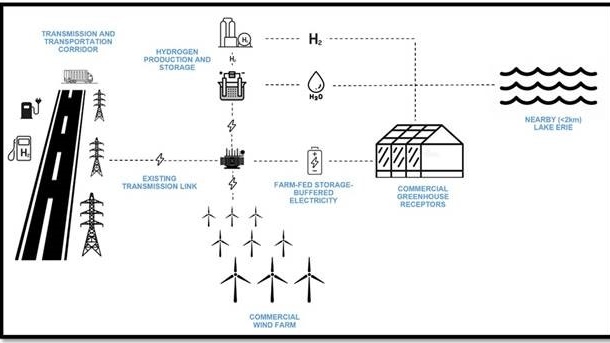Windsor-Essex project looks at potential for wind farms to power greenhouse sector
A new joint venture investigates using existing wind farms to power and heat greenhouses in southwestern Ontario.
The University of Windsor is partnering with the Ontario Greenhouse Vegetable Growers (OGVG) and Kruger Energy for the project.
The HIGH Energy project, short for the Hydrogen Integrated Greenhouse Horticultural Energy project, proposes using wind turbines to generate clean electricity and hydrogen for use in the area’s multi-billion-dollar greenhouse sector.
“Farmers are looking to expand operations and increase their access to low carbon energy solutions,” said Aaron Coristine, OGVG’s manager of science, regulatory affairs and government relations. “This joint venture will construct pathways to achieve this with novel adaptations of clean, proven energy technologies.”
Southwestern Ontario boasts the highest concentration of greenhouses in North America. The greenhouse sector has been rapidly growing, but officials say further expansion is thwarted by a lack of locally available energy. The project aims to provide a solution.
Kruger Energy currently generates 200 megawatts of wind energy in Southwestern Ontario, which is enough to power 60,000 homes, or hundreds to thousands of greenhouse acres depending on crop and growing practice. Wind energy supplied electricity and hydrogen for commercial greenhouse growers. (Source: UWindsor)
Wind energy supplied electricity and hydrogen for commercial greenhouse growers. (Source: UWindsor)
“We’re pleased at the prospect of an additional market for our energy solution,” said JJ Davis, Kruger Energy’s general manager of Canadian operations.
“Kruger is a leader in sustainability and strategic asset management which will enable us to reliably supply clean energy to the vegetable greenhouse sector with our long-established wind farms.”
The project proposes building a commercial facility that takes locally captured wind energy, turning it into electricity and hydrogen for greenhouses that grow tomatoes, peppers, cucumbers, strawberries and other crops. The first step of the project is to do the economic and regulatory modeling to make the business case for the venture.
“There will be a number of firsts in this project,” said Rupp Carriveau, an engineering professor and director of the Environmental Energy Institute at the University of Windsor, who is leading the modelling efforts.
“We anticipate a lot of learning in both the engineering and policy spaces,” he said. “The HIGH Energy project excites us. Using proven existing assets in a new way to improve things or solve a problem, sounds practical and resourceful. We love solutions like that.”
CTVNews.ca Top Stories

BREAKING Israel attacks Iran, Reuters sources say; drones reported over Isfahan
Israel has attacked Iran, three people familiar with the matter told Reuters, as Iranian state media reported early on Friday that its forces had destroyed drones, days after Iran launched a retaliatory drone strike on Israel.
American millionaire Jonathan Lehrer denied bail after being charged with killing Canadian couple
American millionaire Jonathan Lehrer, one of two men charged in the killings of a Canadian couple in Dominica, has been denied bail.
Nearly half of China's major cities are sinking, researchers say
Nearly half of China's major cities are suffering 'moderate to severe' levels of subsidence, putting millions at risk of flooding especially as sea levels rise.
Prince Harry formally confirms he is now a U.S. resident
Prince Harry, the son of King Charles III and fifth in line to the British throne, has formally confirmed he is now a U.S. resident.
Judge says 'no evidence fully supports' murder case against Umar Zameer as jury starts deliberations
The judge presiding over the trial of a man accused of fatally running over a Toronto police officer is telling jurors the possible verdicts they may reach based on the evidence in the case.
Health Canada to change sperm donor screening rules for men who have sex with men
Health Canada will change its longstanding policy restricting gay and bisexual men from donating to sperm banks in Canada, CTV News has learned. The federal health agency has adopted a revised directive removing the ban on gay, bisexual and other men who have sex with men, effective May 8.
Colin Jost names one celebrity who is great at hosting 'Saturday Night Live'
Colin Jost, who co-anchors Saturday Night Live's 'Weekend Update,' revealed who he thinks is one of the best hosts on the show.
Sports columnist apologizes for 'oafish' comments directed at Caitlin Clark. The controversy isn't over
A male columnist has apologized for a cringeworthy moment during former University of Iowa superstar and college basketball's highest scorer Caitlin Clark's first news conference as an Indiana Fever player.
'Shopaholic' author Sophie Kinsella reveals brain cancer diagnosis
Sophie Kinsella, the best-selling author behind the 'Shopaholic' book series, has revealed that she is receiving treatment for brain cancer.
































